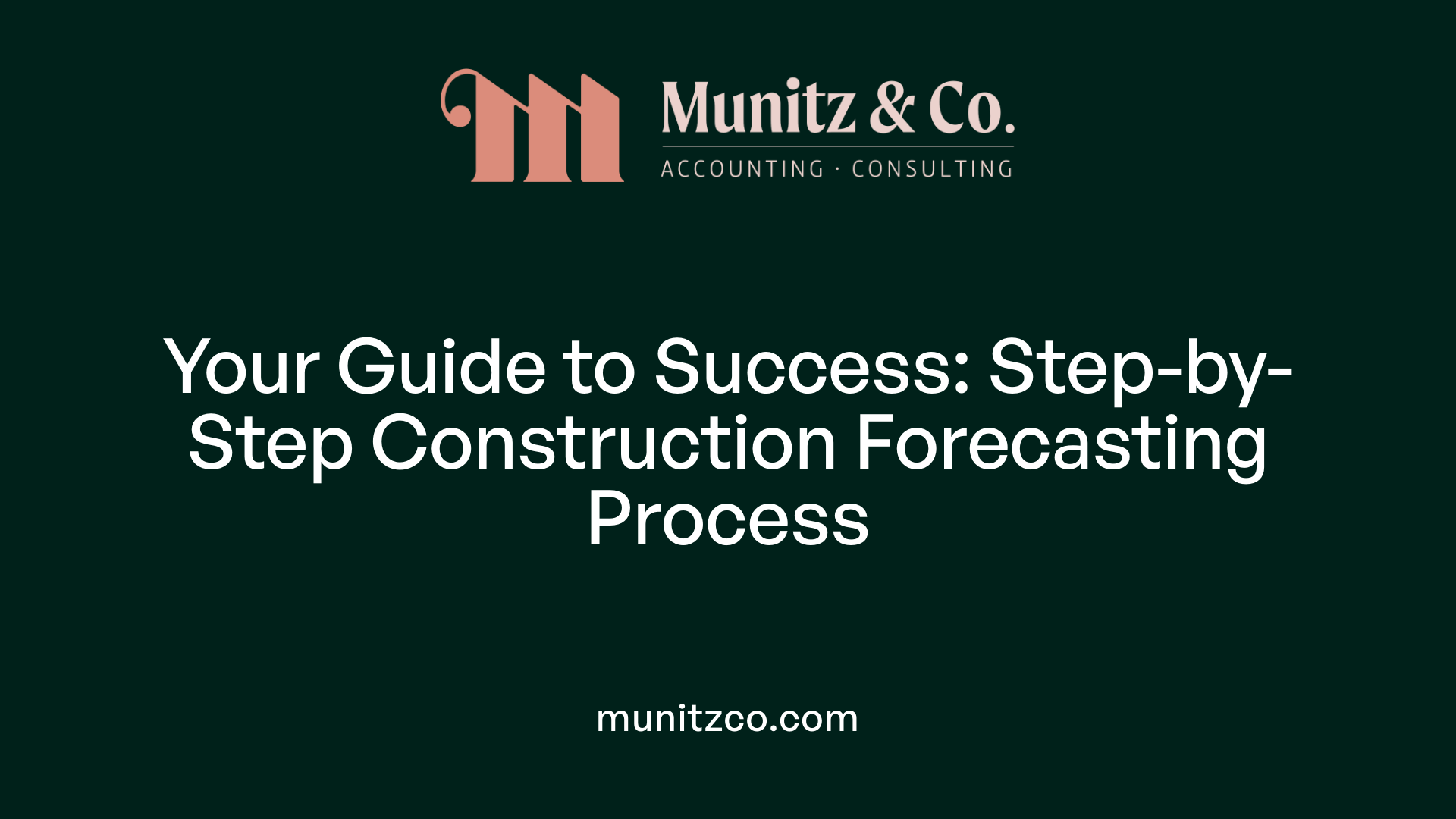Setting the Stage for Reliable Construction Forecasting
In the dynamic world of construction, leaders face the challenge of managing costs, timelines, and resources amid fluctuating market conditions and project complexities. Accurate forecasting emerges as the cornerstone of successful project execution, helping to anticipate future costs, cash flow needs, and potential risks. This guide explores the critical elements of construction forecasting, offering insights and best practices that empower construction leaders to steer projects with confidence and precision.
Understanding Construction Forecasting: Foundations and Importance

What is Construction Forecasting?
Construction forecasting is the process of predicting a project's future costs, cash flow, and overall financial outcomes. This prediction is based on a combination of historical data, current market trends, and specific details unique to each project, such as site conditions and material availability.
How Does Forecasting Predict Project Costs and Financial Outcomes?
By analyzing past costs related to labor, materials, and transportation alongside present market conditions, construction forecasting models estimate upcoming expenses and cash flow needs. These forecasts help in setting realistic budgets and ensuring adequate resource allocation throughout the project lifecycle.
Why is Accurate Forecasting Crucial?
Accurate forecasting is vital in preventing cost overruns, delays, and cash shortfalls. It supports better cost control, schedule stability, risk planning, and ultimately protects project profits. By anticipating potential challenges and financial requirements early, teams can make informed decisions that keep projects on track and within budget.
Effective construction forecasting blends historical insights with real-time data to provide a dynamic and reliable financial outlook essential for successful project execution.
Types of Forecasting in Construction Projects

Cost Forecasting
Cost forecasting predicts the future expenses of a construction project by analyzing past costs such as labor, materials, and transportation. It ensures budgets are realistic, helps control expenses, and mitigates fluctuations in material costs. This forecasting is essential for accurate budget allocation and improved bid accuracy.
Cash Flow Forecasting
Cash flow forecasting estimates the timing and amount of money coming in and going out during the project. It aids in managing funds to avoid cash shortfalls, ensuring that payments to suppliers, workers, and subcontractors happen smoothly. This forecasting supports strategic financial planning and helps keep the project financially stable.
Schedule Forecasting
Schedule forecasting predicts project timelines based on historical data and current progress. It helps identify potential delays and their financial impacts, allowing teams to adjust resources and activities accordingly. Reliable schedule forecasts protect against cost overruns due to extended project durations.
Resource Allocation Forecasting
This type of forecasting focuses on estimating the required labor, equipment, and materials needed at various stages of the project. By anticipating resource needs, it improves productivity and reduces wasted expenses. Considering labor costs, which typically form 20% to 40% of total project costs, is especially important for accuracy.
Risk Forecasting
Risk forecasting identifies possible uncertainties such as weather conditions, market price changes, or scope alterations. This forecasting evaluates their potential effect on costs, schedule, and resources. Early risk detection via forecasting enables proactive management and reduces unexpected disruptions.
Each forecasting type contributes to a comprehensive understanding of a project's future, enabling better decision-making, stronger financial control, and more efficient project delivery.
Key Roles and Stakeholder Coordination in Construction Forecasting

Who Are the Key Players in Construction Forecasting?
Construction forecasting involves multiple stakeholders, each crucial for accurate predictions and smooth project execution. Project managers oversee the entire project, ensuring objectives are met and forecasts align with the timeline and scope.
Finance leads focus on budgeting and cash flow, translating project data into financial plans. Estimators provide detailed cost predictions based on materials, labor, and equipment, forming the foundation of cost forecasting.
Site supervisors contribute day-to-day progress updates and insights into labor productivity and site conditions. Procurement staff manage material purchases and supply timelines, directly influencing cost and schedule forecasts. Client representatives communicate project expectations and approvals, keeping forecasts in line with stakeholder needs.
Why Is Coordination Among These Roles Essential?
Effective communication and collaboration among these stakeholders are vital. Coordination ensures that data from various sources—financial figures, labor updates, material availability, and client inputs—are consolidated accurately.
Without this synchronization, forecasts can suffer from outdated or conflicting information, leading to errors like cost overruns or delays. Regular team meetings and shared digital platforms help maintain alignment, facilitating timely adjustments and continuous forecast updates.
How Does Coordination Impact Forecast Accuracy?
Strong stakeholder collaboration enhances the reliability of forecasts by integrating diverse expertise and real-time data. It supports proactive identification of risks, enabling the team to implement corrective actions swiftly.
By fostering transparency and accountability, coordinated efforts reduce the chances of miscommunication and data gaps, which are common forecasting challenges. This collective approach leads to improved budget control, schedule stability, and overall project success.
Step-by-Step Construction Forecasting Process

Defining Scope and Objectives
The construction forecasting process begins with clearly defining the project's scope and objectives. This involves detailing the deliverables, timelines, costs, and quality requirements. Using tools like the Work Breakdown Structure (WBS), project scope is organized into manageable components with defined costs and deadlines to establish a strong foundation for accurate forecasting.
Gathering Historical and Current Data
Next, relevant past and present data are collected. Historical data includes previous project costs such as labor, materials, and transportation expenses, while current market trends consider economic conditions, supply chain status, and material availability. Incorporating external factors like weather or market price fluctuations helps create a comprehensive dataset.
Analyzing Figures
The gathered data is then analyzed to identify trends, risks, and cost drivers. This step accounts for critical variables such as labor productivity and site-specific conditions that influence cost variation. Quantitative and qualitative forecasting techniques aid in evaluating the data to establish realistic expectations.
Creating Forecast Models
Based on the analysis, forecast models are built to predict future project costs, cash flow, and scheduling outcomes. These models integrate historical insights, market dynamics, and project-specific factors. Advanced technology like real-time data tools or Building Information Modeling (BIM) can enhance model accuracy.
Team Review
Once preliminary forecasts are developed, a review is conducted with key stakeholders including project managers, cost engineers, finance leads, and procurement staff. Team discussions ensure assumptions are valid, identify gaps, and foster alignment across departments for improved accuracy.
Continuous Updating of Forecasts
Construction forecasting is an iterative process. As projects progress, forecasts must be regularly updated to reflect changes in scope, costs, or schedule. Frequent re-forecasting allows for better control of budgets and risks, facilitating proactive decision-making throughout the project lifecycle.
Leveraging Historical Data and Market Trends for Forecast Accuracy

Analyzing Past Costs: Labor, Materials, Transportation
Effective construction forecasting begins with a thorough analysis of historical costs. Labor, typically accounting for 20% to 40% of a project's cost, is particularly challenging to predict due to variables such as productivity, skill levels, and additional employee expenses. Additionally, material expenses and transportation costs from past projects must be carefully examined to identify patterns and set realistic expectations.
Impact of External Factors
External elements, including economic conditions, weather, and supply chain disruptions, significantly influence forecast accuracy. Recessions, fluctuating market prices, and delays in material deliveries can cause unpredictability. Understanding these factors through historical trends allows for better risk planning and cost control.
Incorporation of Current Market Trends
Integrating current market data into forecasting models refines predictions. Live market feeds and up-to-date pricing trends enable more informed budgeting and cash flow management. This dynamic approach helps mitigate risks associated with material cost fluctuations and economic shifts.
Project-Specific Details
Each project presents unique variables such as site conditions, labor requirements, and scope changes. Tailoring forecasts to include these specifics ensures more accurate and realistic outcomes. Techniques like the Work Breakdown Structure (WBS) assist in organizing scope into manageable deliverables with defined costs and deadlines.
By combining detailed historical data, awareness of external influences, current market trends, and project-specific factors, construction forecasting achieves higher precision, helping avoid cost overruns and schedule delays.
The Role of Forecasting Tools and Technology in Enhancing Precision
Software Tools for Comparing Budget, Forecast, and Actual Costs
Construction forecasting tools play a crucial role in managing project financials effectively. They allow teams to compare the original budget against updated forecasts and actual costs incurred. This continuous comparison helps identify potential overruns early, enabling prompt corrective actions to keep projects on track financially.
Real-Time Data Gathering and Collaboration
Technology now makes it possible to gather live data from various project sites through IoT devices, sensors, and integrated platforms. This real-time data provides a dynamic view of financial and operational status, allowing project teams to collaborate instantly. Improved communication across stakeholders leads to more accurate and timely forecasting updates, significantly reducing risks associated with delays or cost surprises.
Examples of Technology Solutions like Archdesk and CMiC ERP
Advanced software solutions such as Archdesk and CMiC ERP are revolutionizing construction financial management. Archdesk enhances forecasting precision by automating data collection and supporting real-time collaboration among teams. CMiC ERP offers comprehensive capabilities including real-time financial data monitoring, accounting, payroll, and equipment management, which supports informed decision-making and efficient resource management.
Automation in Forecasting Processes
Automation simplifies complex forecasting steps by integrating historical data analysis, live market trends, and project-specific inputs into predictive models. Automated systems reduce manual errors, enable frequent re-forecasting, and support scenario simulations for risk planning. This automation streamlines workflows, allowing project teams to focus on strategic planning rather than administrative tasks.
Technology and forecasting tools combined offer construction projects enhanced accuracy, improved efficiency, and better financial control. Their integration into project workflows is essential for meeting budget and schedule goals in today's dynamic construction environment.
Addressing Challenges in Construction Forecasting
What causes limited scope visibility in construction forecasting?
Limited scope visibility stems from unclear project definitions and frequent changes during execution. When the project scope is not well-defined or evolves without proper documentation, forecasting becomes less reliable. This lack of clarity complicates the prediction of costs, timelines, and resource needs.
How does inconsistent forecasting methods affect accuracy?
Using varied forecasting techniques across teams or projects leads to inconsistent results. Without standardized methods, data analysis and model creation can vary widely, causing discrepancies and reducing confidence in financial and schedule forecasts. This inconsistency can also hinder comparisons across projects and delay corrective actions.
What problems arise from late or unreliable data?
Late or inaccurate data disrupts timely decision-making. If financial figures, material availability, or progress updates come in too late or are erroneous, forecasts quickly become outdated or misleading. This impedes cash flow management, risk mitigation, and schedule adherence.
Why is poor coordination among stakeholders a problem?
Poor coordination between project managers, estimators, procurement, site supervisors, and clients results in fragmented data sharing and misunderstanding of project conditions. Misaligned communication can cause delayed updates, overlooked risks, and unanticipated expenses, directly undermining forecast precision.
What solutions improve construction forecasting accuracy?
- Early involvement of controls: Engaging forecasting and financial control teams from the project’s outset allows better scope definition, improved data gathering, and proactive risk management.
- Standardized processes: Implementing uniform forecasting procedures and templates ensures consistency in data analysis and model generation.
- Better integration: Leveraging technology that connects stakeholders, such as ERP systems and collaborative software, enables real-time data sharing and unified decision-making.
Together, these solutions address common forecasting challenges by enhancing scope clarity, data reliability, methodological consistency, and stakeholder collaboration, ultimately improving project predictability and financial outcomes.
Advanced Techniques Improving Forecasting Accuracy
How Does Real-time IoT Data Integration Enhance Construction Forecasting?
Real-time Internet of Things (IoT) data integration introduces dynamic and immediate insights into construction forecasting. Sensors placed on equipment, materials, and job sites continuously feed data on conditions, usage, and progress. This live data helps detect issues early, track resource utilization, and adjust forecasts as work unfolds, reducing delays and budget surprises.
What Role Does Building Information Modeling (BIM) Play in Forecasting?
Building Information Modeling (BIM) provides a detailed digital representation of a construction project linking physical and functional characteristics. BIM integration with forecasting allows for precise visualization of project stages, better coordination among teams, and assessment of impacts from scope or design changes. This leads to improved schedule and cost predictions.
How Do Live Market Feeds Contribute to More Accurate Forecasts?
Live market feeds deliver up-to-the-minute information on material prices, labor rates, and economic conditions. Incorporating this data into forecasting models accounts for sudden market fluctuations, helping to mitigate risks and prevent cost overruns caused by unexpected price changes.
What Is the Impact of Scenario Simulations and What-if Analysis?
Scenario simulations and what-if analysis enable project teams to explore various potential outcomes by manipulating variables such as resource availability, weather events, or supply chain disruptions. This proactive approach tests multiple scenarios, supports risk planning, and helps make informed decisions to safeguard schedules and budgets.
These advanced techniques combined create a more responsive and data-driven forecasting process. By harnessing real-time data, integrated digital models, market intelligence, and simulation tools, construction projects benefit from enhanced accuracy, better risk management, and improved overall financial control.
AI’s Transformative Impact on Construction Forecasting
How Does AI Enable Early Risk Detection in Construction Forecasting?
AI empowers construction forecasting by analyzing vast amounts of real-time and historical data to identify potential risks before they escalate. By spotting patterns and anomalies, AI can flag issues such as supply chain disruptions, labor shortages, or cost surges at an early stage, allowing project teams to proactively respond and mitigate risks.
In What Ways Does AI Improve Cost Predictions?
Through machine learning algorithms, AI refines cost forecasting by continuously learning from past projects and current market variables. This results in more precise estimations of labor, material, and other expenses, accounting for dynamic factors like fluctuating prices and site conditions. Consequently, AI enhances budget accuracy and reduces the likelihood of costly overruns.
How Does Automation Enhance Forecast Adjustments?
AI automates the process of updating forecasts by integrating new data inputs seamlessly, reducing manual effort and the chance of human error. Automated systems can instantly adjust forecasts based on live project changes, such as schedule shifts or resource availability, ensuring that project managers always rely on the most current information.
Why Are AI-Driven Models More Dynamic and Accurate?
AI-driven forecasting models are adaptive, continuously adjusting to inflows of fresh data and evolving project parameters. This flexibility results in dynamic models that reflect real-time conditions, improving the accuracy and responsiveness of financial and schedule forecasts. These models support better decision-making and help maintain project control throughout the lifecycle.
Construction Cost Forecasting as a Strategic Project Management Function
Who Handles Construction Cost Forecasting?
Construction cost forecasting is primarily managed by cost engineers, often known as quantity surveyors. These professionals specialize in estimating and predicting the financial costs tied to a project, ensuring that budgets reflect realistic expectations.
How Does Collaboration Enhance Forecast Accuracy?
Effective construction cost forecasting thrives on collaboration among a diverse group of stakeholders. Cost engineers work closely with clients to understand project goals, with architects and engineers to capture design and technical specifics, and with suppliers to get timely pricing information. This team effort enables the creation of financial models that are grounded in practical, real-world data.
What Are the Expectations for Setting Realistic Budgets?
Setting a realistic budget demands a comprehensive approach that combines historical cost data, current market trends, and precise project details such as labor productivity and material availability. It involves accounting for potential schedule changes and unexpected costs, providing a financial roadmap that guides the project from conception through completion without major surprises.
How Does Forecasting Help Mitigate Material Cost Fluctuations?
One of the challenges in construction is the volatility of material prices. Through continuous market analysis and close supplier relationships, forecasting helps anticipate these fluctuations. Timely adjustments to procurement strategies and budget allocations can then be made, reducing financial risks and protecting project profit margins.
By integrating expert knowledge, tight collaboration, and market-aware strategies, construction cost forecasting serves as a strategic function in project management. It not only supports accurate budget allocation and resource management but also fortifies projects against the unpredictability of material costs and other financial uncertainties.
Integrating Financial Management and Forecasting in Construction
Budgeting and Cost Management
Effective budgeting in construction forecasting sets the foundation for controlling costs throughout a project's lifecycle. By leveraging historical data and project-specific details, construction teams can establish realistic budgets that accommodate labor, materials, and potential fluctuations. Cost management then ensures these budgets are monitored and adjusted by comparing forecasted costs with actual expenditures, preventing overruns and financial surprises.
Financial Performance Assessment Tools
Construction financial managers depend on tools such as financial ratios and earned value analysis to gauge project health. These metrics offer insights into cost efficiency, schedule adherence, and value delivered relative to spend. Combined with forecasting software, they enable continuous performance tracking and early detection of financial risks.
Cash Flow Management
Forecasting extends to projecting cash flow, a critical aspect in construction where expenses and income may not align perfectly over time. Accurate cash flow forecasts help ensure adequate funding is available when needed, reducing the risk of shortfalls that could delay progress. Integrating real-time financial data with forecasting models improves responsiveness to financial changes.
Risk Management Practices
Construction projects face variety of financial risks including cost variation, market price changes, and scope growth. Forecasting supports risk management by identifying potential financial threats early and enabling contingency planning. Regular re-forecasting throughout the project aids in adapting strategies to evolving conditions, maintaining financial stability.
Strategic Financial Planning and Profit Maximization
Strategic management involves using forecasts to align financial goals with project objectives. Profit maximization strategies such as value engineering, strategic procurement, and adopting innovative technologies can be guided by accurate forecasting data. This proactive approach ensures not only budget adherence but also enhances overall project profitability and success.
Planning for Labor and Resource Allocation Forecasts
How Do Labor Costs Impact the Overall Project Cost?
Labor expenses form a significant portion of construction budgets, typically accounting for 20% to 40% of total project costs. These costs include wages, benefits, and additional employee expenses. Given their substantial share, even small inaccuracies in labor cost forecasting can lead to notable budget overruns.
Why Is Workforce Productivity and Skill Variability Important?
Workforce productivity and skill levels vary widely, making labor cost prediction challenging. Factors such as worker experience, efficiency, and varying site conditions influence daily output. Unanticipated drops in productivity or skill shortages can delay timelines and increase labor expenses.
What Is Resource Allocation Forecasting?
Resource allocation forecasting involves predicting the quantity and timing of labor, materials, and equipment needed throughout the project. This forecasting ensures that the right resources are available when required, optimizing efficiency and preventing bottlenecks. It requires detailed analysis of project scope, current and historical resource usage, and market availability.
Why Are Realistic Deadlines and Project Duration Analysis Crucial?
Accurate forecasts depend on realistic project timelines. Unrealistic deadlines can cause rushed work, increased overtime costs, and reduced quality. By analyzing historical data and considering current site conditions, teams can set achievable project durations that align with labor availability and productivity, minimizing the risk of cost overruns.
Effective labor and resource forecasting is a dynamic process combining detailed data analysis with ongoing communication among project managers, site supervisors, and procurement staff. Incorporating technology and collaborative workflows further refines accuracy and supports proactive decision-making.
Maintaining Forecast Accuracy Through Regular Updates and Collaboration
Why Is Re-Forecasting Crucial Throughout the Project Lifecycle?
Regular re-forecasting is essential to maintain accuracy in construction forecasting. As projects progress, conditions shift due to changes in scope, unforeseen external factors like weather, or fluctuations in material costs. Updating forecasts frequently helps identify emerging risks early, prevent cost overruns, and keep project timelines and budgets realistic.
How Does Team Collaboration Influence Forecasting Success?
Team collaboration is foundational for precise forecasting. Establishing a structured planning workflow that promotes communication among project managers, cost engineers, site supervisors, and procurement staff ensures all parties share relevant data promptly. This collective effort minimizes errors and supports cohesive decision-making.
What Role Does Stakeholder Engagement Play in Timely Data Collection?
Engaging all stakeholders—including contractors, suppliers, and client representatives—is critical for obtaining timely and reliable data. Effective communication channels allow for quick updates about changes in labor availability, material deliveries, or scheduling adjustments, which directly impact forecast accuracy.
How Can Planning Workflows Help Avoid Organizational Chaos?
A well-designed planning workflow assigns responsibilities clearly and schedules regular forecast reviews. It integrates data from multiple sources through tools and software, such as Archdesk or CMiC ERP, enabling real-time updates and preventing fragmented information. This organized approach reduces misunderstandings and enhances forecasting efficiency.
In summary, maintaining forecast accuracy requires continuous updates through re-forecasting, active collaboration across teams, engaged stakeholders providing real-time input, and a robust planning workflow to unify efforts. These practices collectively improve control over project costs, schedules, and outcomes.
Maximizing the Benefits of Construction Financial Management Software
Training and Customization Approaches
Effective use of construction financial management software begins with comprehensive training tailored to the diverse roles involved—project managers, finance leads, estimators, and procurement staff. Customization is equally important, allowing firms to adapt the software to their unique workflows, project types, and reporting requirements. This ensures the platform supports all critical aspects, from budgeting and cost management to risk assessment and stakeholder communication.
Ongoing Support for Software Utilization
Sustained success depends on ongoing support, including regular updates, troubleshooting, and user assistance. This encourages consistent engagement by users and helps incorporate new features or regulatory changes swiftly. Many firms establish dedicated support teams or partnerships with software providers to maintain seamless operations and quickly address potential issues, thus preventing disruption in financial management.
Enhancing Decision-Making and Operational Efficiency
By leveraging real-time financial data and automated processes, software solutions like CMiC ERP and Archdesk empower construction teams to make data-driven decisions. Features such as live cost tracking, cash flow projections, and schedule forecasting enable proactive risk management and resource allocation. The collaboration tools embedded in these platforms facilitate information sharing across stakeholders, improving accuracy and timeliness in forecasting, budgeting, and project execution.
Case Examples of Software Impact
Companies adopting construction financial management software report reductions in cost overruns and improved budget adherence. For example, firms utilizing Archdesk experienced greater forecasting precision and accelerated data collection, while others using CMiC ERP gained enhanced visibility into labor, payroll, and equipment costs. These improvements supported smoother project delivery and stronger financial performance, highlighting the value of technology in modern construction management.
Building Forecasting Confidence for Construction Success
Effective construction forecasting is more than a technical necessity; it is a strategic imperative that equips leaders with the foresight to navigate uncertainty and complexity. By embracing structured processes, fostering collaboration across key roles, leveraging advanced technologies, and committing to continuous updates, construction leaders can secure project budgets, optimize resources, and safeguard profitability. This guide underscores that forecasting with confidence stems from integrating data-driven insights, expert knowledge, and adaptive tools—ensuring projects not only meet but exceed their financial and operational targets.







